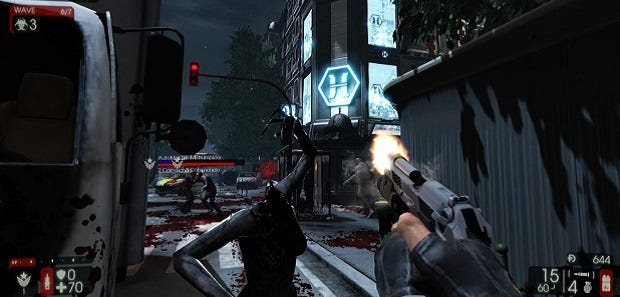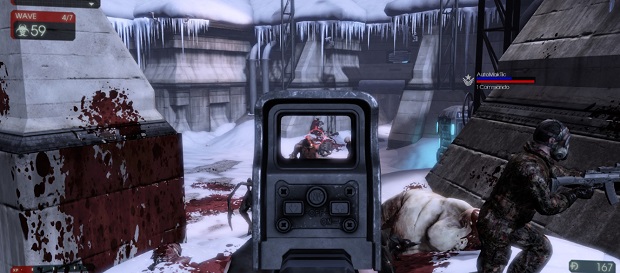Hands On: Killing Floor 2
From Argh to Zed
It has been a decade since the original Killing Floor mod for Unreal Tournament, which was released in much-improved standalone form in 2009. It's one of those games that quickly turns some people off: the visuals were a bit shonky, it was essentially built on repetition, and the less said about the Dick van Dyke voice-acting the better. But for devotees, Killing Floor is one of those games that stealthily racks up several hundred hours on Steam and swiftly becomes a fixture among like-minded mates, a precision blastathon where the repetition is the whole point.
You got better; the game got deadlier. And Killing Floor 2 [official site] is as straightforward a reload as you're ever likely to see.
In a narrative terms, Killing Floor 2 is a direct sequel – but in the hands it feels much more like a remake. This is not a negative: for every sequel that improves on an original, there are many more that ruin what made it special. For existing players, KF 2 will be a dream, a straight upgrade with a few judicious changes. For new players it's a bit more complex, because the FPS market (and specifically the wave-based niche that KF played a big part in kick-starting) is much richer than it was in 2009. Thanks to Steam sales surely everyone owns Left4Dead 2 by now, not to mention high-quality stuff like Payday.
Killing Floor 2 is a six-player co-op shooter where waves of 'Zeds' and special infected swarm your team for minutes at a time, before brief rest periods where you can buy new equipment and restock armour, ammo and grenades. Players have the option when setting the game up to choose between 4, 7 or 10 waves before a boss, with the potential XP rewards commensurately greater, and of course can move the difficulty from Normal to You Die On Wave One mode (not the actual name, though it should be).
One of the things that sets KF2 apart is in how weapons are split up among the classes, referred to here as 'perks.' So Commandos start with assault rifles and should be popping heads at range, while Berserkers are melee and Support default to a shotgun. This in itself gives teams an organic interplay that doesn't require any communication to set up – you know what your role is from the first second.
However in what is either an oversight or an odd change, it feels like KF2 no longer has penalties for using other class gear – in the original if you picked up a shotgun as a Commando, for example, you could happily use it but would have greater recoil than a Support character. This always seemed to me a sensible constraint rather than anything punitive, and perhaps now's the time to mention that when the game releases on April 21 it will be as an Early Access title. There are four perks here but ten are planned, alongside many more weapons and maps. Developers Tripwire Interactive have had, shall we say, some iffy launches in the past and clearly want to avoid that here – and, to be fair, the beta ran beautifully with zero hitches.
Let's stay on the guns for a moment, however, because they are one of the standout aspects of KF2. I played mainly as the Commando class, in order to channel my mighty CS: GO skills, and the kick from each rifle burst is gorgeously-weighted – even better is the balance between your firing modes. Tapping out single shots lets you keep the reticule more or less in place, encouraging patient and precise aiming, but when things get hairy short bursts will land accurately while also kicking your aim a few feet above the oncoming horde. Full auto fire is just uncontrollable, reserved only for true mosh pit scenarios, and so it's the tension between tap and burst that defines Commando play. Tap, tap, burst, the quick pulldown to regain control, and tap onwards. When a videogame gun behaves like this it's a delicious sensation, because it feels like a physical weapon rather than a fantasy lasergun. A quick word, too, for the long reload times, which induce panic in the midst of a scrum and encourage quick-swapping rather than sticking with one weapon throughout.
Melee combat, too, is much-improved over the original game, where I never felt it was worth bothering with. A new parry move lets skilled players go head-to-head with more deadly opponents without taking damage (though latency is sometimes an issue), but by far the biggest difference is in the impact. KF2 is a very gory game in general, with enemies crumpling brutally under your blows and bits flying off them, and one of the standout new 'features' is that bloodstains remain on the map. Entirely incidental this may be, but it's kind of amazing to fight your way out of a corner when surrounded by 10 enemies and, a few minutes later, catch sight of the entirely red scenery and be reminded of what happened.
Getting in the mix is what KF2 is really about, and the game's most distinctive feature ties into this: Zed mode, aka slow-motion. It's unclear what exactly triggers this, though it seems to come up frequently after headshots, but every so often during the waves the game slows down for four or five seconds. It's a brilliant mechanic because the nature of KF2's gunplay is high-impact chaos, so the opportunity to take a breath and pick out headshots in the midst of this just feels amazing.
KF2's locations are basically circular and warren-like, with plenty of potential Alamos. They're not especially large and, if you know where you're going, are easy to navigate from end-to-end in a short amount of time (perfect for a wave-based shooter) and most of the preferred holdout locations still have several points of entry for enemies that it's all-too-easy to lose track of. One change from the original, and for the better, is that doors are now a finite resource: you can weld them shut to hold off Zeds but, once they're broken through, that's it for the match. On harder difficulties this becomes a major deal because it's so tempting to make your life easier by closing off a few entry points, but you really want to save them for the last waves and if possible the boss – and you'll feel the pain when you don't.
On that note, my only major disappointment with KF2 was the new boss, some sort of evil doctor that is deadly at all ranges and goes through three attack phases. He can kill you from a massive distance with witheringly accurate fire and, up-close, he does incredible melee damage, as well as throwing grenades. If there's one thing KF2 gets right it's the pacing, but the sudden switch from wave-based onslaughts to a single enemy that you basically just have to keep running away from is a jarring one. What makes it worse is that there's a glitch where he'll get obsessed with a newly-welded door and stand there bashing it while the team unloads on his back, which is how my two encounters with him ended up. After the game's white-hot intensity to this point, it feels like a comedown.
Perhaps it's Zed mode that hints at what makes KF2 worth paying attention to, despite the odd misstep. There are aspects of this game that simply won't be for everyone. I find the aesthetic a bit too teenage death metal for my tastes, got bored of killing zombies years ago, and don't find gore especially captivating.
But KF2's core mechanics are so finely-tuned, with every single one having a clear place in the carnage, that none of this matters in the slightest. Early Access in recent times has felt like a codeword for 'unfinished mess,' but here it's an opportunity to get in on the ground floor of a solid shooter that will only get better. KF2 demands focus for every second and is an experience that takes over, one of those where you'll sit down for a game and then realise it's 3am. The guns feel fantastic, the perks complement each other beautifully, and when the going gets tough the action is white-hot. It's not the most sophisticated game I've ever played; but some Zeds just need killing.














